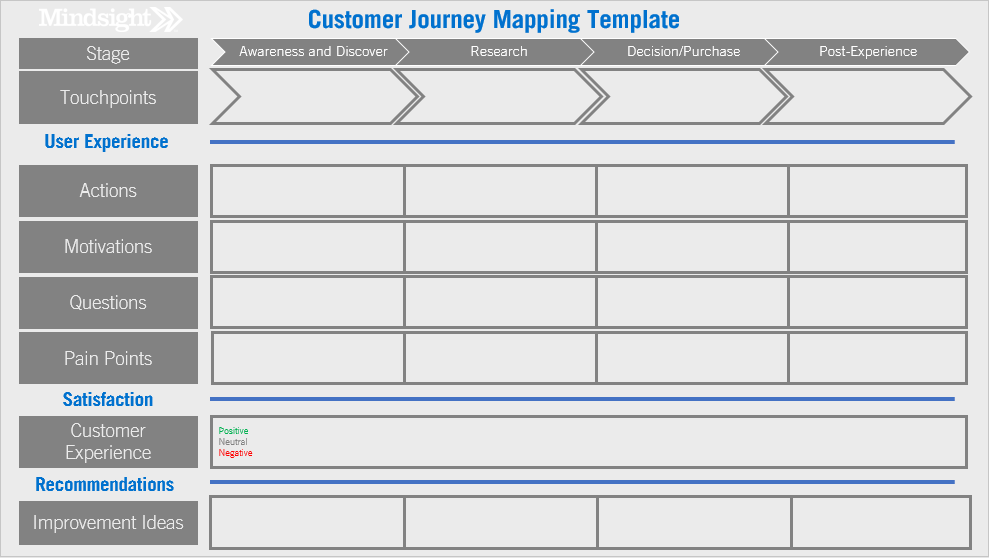July 13, 2017
Business are always trying to step into the minds of their customers. If they can accomplish that, they can generate more sales, create a better customer experience, and ultimately become a more successful business. Though businesses often have vast databases of customer data, it doesn’t exactly tell a story or allow you to adopt the customer mindset.
Though some business data is quantitative, much of it as qualitative as well. So, businesses must dig deeper to understand how customer activity relates to the buying process and the business’s own customer service processes. This is where a customer journey map steps in.
A customer journey map locates the different interactions the customer has with the business and attempts to infer customer motivations, concerns, and frustrations at various points in the buying process. By understanding customer motivations, you can anticipate where customers get confused, where they lose interest and attempt to circumvent these roadblocks. To do that, your map needs to address the customer journey from several angles.
Beneath the Data: The Customer Experience
- Customer Interactions: The most fundamental component of the journey map are the various times and ways in which the customer will interact with the business. Clearly mapping these processes out and understanding what makes these interactions succeed or fail is crucial to stepping into the customer’s shoes. Yet, for many businesses, that is where the journey map ends. There is so much more to cover than just interactions. You should use these interactions as merely a starting point of your analysis.
- Goals and Frustrations: In each of these customer interactions, the customer has their own personal emotions affecting how these interactions resolve. You must understand the customer’s goals in the conversation, because they will almost certainly differ from the business’s goals. The business wants to make a sale; the customer wants to solve a problem. There’s overlap to be found, but they are not exactly the same goals.
- Customer Emotions: Understanding the customer’s emotions is slightly different than understanding their goals and frustrations, and the distinction is important. Many buying decisions are emotional ones. Customers want to feel like they are making the right choice, that they can trust the business, how the purchase will reflect on them. The brand and business affect all of these considerations. Apple is a perfect example of this. In some ways, apple products can be seen as a status symbol. Their cool factor and sleek design reflects on the buyer in the community. Similarly, the customer may have frustrations they are not vocally sharing with the business. Anticipating these frustrations will enable you to promote clear communication and find real solutions to the customers underlying problems.
- Customer Evaluation: The best way to learn what your customers are thinking is to ask them. The whole goal of this exercise is to improve the customer experience, and customer feedback is critical to improving the results of this process. Surveys and reviews will give you excellent insight of the customer’s general or specific impressions of the customer journey they have just completed.
Data Is a Tool, Not Truth
Customer data is not necessarily the definitive and all-encompassing truth of the customer journey. It is a tool to be analyzed and understood, and that analysis should factor into a larger understanding of the customer journey. You must dig deeper to understand your customer journey and move from there. Also, recognize that the customer journey is an evolving thing. Reevaluate your journey map consistently to make sure it still aligns with reality.
Like what you read?
About Mindsight
Mindsight, a Chicago IT services provider, is an extension of your team. Our culture is built on transparency and trust, and our team is made up of extraordinary people – the kinds of people you would hire. We have one of the largest expert-level engineering teams delivering the full spectrum of IT services and solutions, from cloud to infrastructure, collaboration to contact center. Our highly-certified engineers and process-oriented excellence have certainly been key to our success. But what really sets us apart is our straightforward and honest approach to every conversation, whether it is for an emerging business or global enterprise. Our customers rely on our thought leadership, responsiveness, and dedication to solving their toughest technology challenges.
Contact us at GoMindsight.com.
For Further Reading

